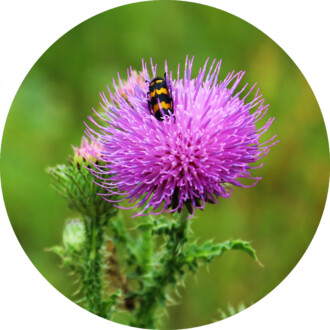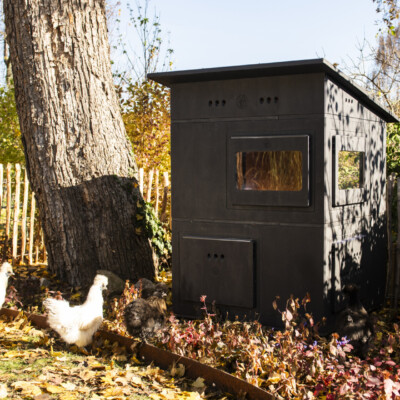Of course, for many people, their own garden, terraces or balconies are first and foremost their own private paradise: A place to retreat to after a hard day’s work, the perfect space for children to play and explore, or simply the easiest way to experience the wonder of nature up close. Garden & Co also offer you a special opportunity: to make an important contribution to nature conservation and environmental protection by making this valuable environment bird-friendly.
The origins of nature conservation lie in bird protection. And this is more necessary today than ever before: the number of birds in our meadows and fields has halved in the last 25 years (source: Birdlife Austria). The situation is particularly dramatic for the following species, for example:
- Corn bunting: -95%
- Serin: -89%
- Partridge: -76%
- Field larch: -50%
As there are birds practically everywhere, their protection does not only take place in some distant national park, but also and above all right on your doorstep: private and public gardens and other green spaces are a central habitat for birds. Therefore, bird-friendly gardens naturally have a very high species diversity and bird density.
For you, this means that you can make an important contribution to nature conservation with relatively little effort. The following 7 measures in particular are available to you (in order of the effort required to implement them):
- hang up nesting boxes
- provide food
- create watering holes
- plant flowering perennials
- plant wild shrubs
- leave dead wood (“wild corner”)
- plant or preserve trees
The more you can do, the better! Even if you only have a patio or a small balcony, you can quickly do something good (1, 2 and 3 can be implemented regardless of your living environment).
However, birds are not only incredibly important for nature and the environment (which may sound a little abstract): As an aside, they also solve a concrete problem in your garden and take work off your hands – namely, because insects are their main source of food.
> My TIP: “In a bird-friendly garden, you can also get by much better without pesticides and insecticides, because garden birds such as tits are constantly on the lookout for aphids, moths and the like.”
Hanging up nesting boxes
… so that the birds can breed in peace:
It is essential for the survival of birds that their natural habitats remain intact and that they find suitable nesting opportunities. Unfortunately, this is becoming increasingly difficult for many bird species. The starting point of this problem is the fact that the original habitats are being pushed back further and further. In managed, “cleared” forests, for example, there is a lack of old trees suitable for nesting and other woody plants suitable for breeding. The form of agriculture that is predominantly practiced today leads to an even more drastic decline in habitats. Even the alternative habitats in residential areas often no longer offer the necessary niches and other comparable retreats due to the increasingly linear nature of residential construction.
But there is also good news: Fortunately, birds are very happy to accept “artificial” breeding sites. Therefore, everyone can do a good deed in terms of nature conservation by providing birds with more nesting opportunities, e.g. in the form of nesting boxes. With the right design, nesting boxes can also fulfill the important function of winter quarters for birds, insects and small mammals (bats, squirrels, dormice, mice, etc.) outside the breeding season.
> My TIP: “To make sure your nest boxes are occupied, it’s best to hang them up in October! Tits, for example, already inspect potential breeding sites in the winter months.”
Before the eggs are laid, the birds want to get used to their new home. An exception can be made for the common redstart, for example, which only returns from its winter quarters late in the year (late April / early May) and then often has difficulty finding an unoccupied nesting site.

Provide food
… preferably all year round:
From the end of October at the latest, you should also start thinking about winter feeding, because then you have a better chance of regular visits. A feeding station, e.g. a feeding house outside the window, provides numerous opportunities to experience native birds up close. Especially when natural food is difficult to access, dry feeders can be a great help.
Winter feeding is certainly the more important, but contrary to popular belief, the latest scientific research says that birds should be fed all year round.
Create water points
… for drinking and bathing:
Birds love water: be it as refreshment for drinking, as a bath for preening or as cooling on hot days. It is therefore a good idea, especially in summer, to provide the birds with a place with fresh, clean water. All kinds of shallow containers in which the water cannot run off and which have a slightly wider rim are suitable for this purpose – this also gives the birds a good place to stand. The water should not be deeper than 1 to max. 2 cm so that the bowl can also be used for extensive bathing.
It is also important that the water bowl is hung up in a cat-proof place (e.g. on a tree) and ideally cleaned daily.

Planting flowering perennials
… as a source of food:
Especially in summer, flowering perennials are real magnets for insects of all kinds, which find food here. Yes, and insects in turn are the most important food for your garden birds.
> My TIP: “Don’t cut back the seed-bearing perennials until after winter, as this allows many insects to overwinter in your garden. Otherwise, you would simply dispose of them in the fall. What’s more, the seeds that remain on the seed heads are ideal winter food for birds.”
The following perennials are particularly suitable for a bird-friendly garden – to name just a few:
- wood angelica
- chicory, wild carro
- meadow daisy, dove scabious
- knapweeds
- meadowsweet, large-flowered and black mullein
- sweet clover
- thistles, wild teasel
- viper’s bugloss
- yarrow

Planting wild shrubs
… so that birds can retreat to protected areas at any time:
Wild shrubs fulfill two tasks at once: On the one hand, they provide space for nesting and on the other, they serve as an important source of food for birds. Many bird species love the fruits of various wild shrubs: here they not only satisfy their hunger, but also their thirst.
Native trees and shrubs are particularly suitable for bird protection, as the native bird world has adapted to them over the centuries. Dense hedges, perhaps even some with spines or thorns, are ideal as protection against nest predators.
> My TIP: “Targeted pruning of these shrubs can also help the free-nesting birds: if you remove a vertically growing main shoot, the surrounding side shoots will form a good framework for a nest.”
The following trees and shrubs should not be missing in a small bird paradise:
- blackberry, bilberry, bird cherry
- cornelian cherry
- black elder
- wild grape
- hawthorn,
- pear tree
- dog rose, rowan berry
- sloe / blackthorn, spirea
- viburnum
It would be very helpful for your garden birds if the shrubs in your garden bear fruit at different times.
Leave dead wood lying around (“wild corner”)
… another breeding ground for bird food:
A “wild corner” refers to untidy corners in the garden. These attract many insects – much to the delight of your garden birds – and also serve as a habitat and hibernation site for other small animals.
A pile of leaves left lying around in the fall and an open compost heap serve a similar purpose and will quickly increase the diversity of species in your garden.
Planting or preserving trees
… probably the most important habitat for birds:
“Priceless” in any case are large, old trees (especially fruit trees). Of course, not every garden has a stock of old trees, but every tree was planted once or grew from a seed. Therefore:
> My RECOMMENDATION: “Better to plant tomorrow’s tree now than never!”
















